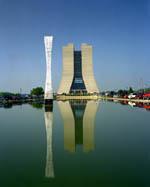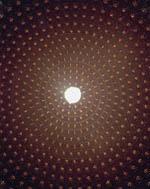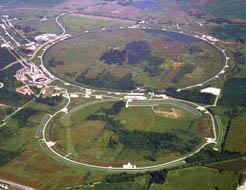 |

















|
 |

Home Page Images
 |
Reflection of Wilson Hall and the
sculpture "Acqua Alle Funi"
A Gothic cathedral in Beauvais, France inspired the design for the laboratory's
16-story headquarters building. Wilson Hall actually consists of two
connected towers, each able to move to absorb the
stresses of wind and weather. The east and west
towers, and north and south crossovers, surround a
skylighted atrium that soars to the full 238-foot
height of the building. Wilson Hall also houses Ramsey
Auditorium, an 800-seat venue suitable for arts
presentations and for meetings of experiment collaborations that can number several hundred physicists.
|
 |
The MiniBooNE detector
The inside of the MiniBooNE tank is covered
with 1280 photomultiplier tubes. The picture shows a section
of the upper hemisphere of the tank. MiniBooNE will investigate the question of neutrino mass by searching for neutrino oscillations from muon
neutrinos to electron neutrinos. This will be done by directing a muon neutrino beam into the MiniBooNE
detector and looking for electron neutrinos. This experiment is motivated by the oscillation results
reported by the LSND experiment at Los Alamos.
By changing the muon neutrino beam into an anti-neutrino beam, MiniBooNE can explore oscillations from
muon anti-neutrinos to electron anti-neutrinos. A comparison between neutrino and anti-neutrino results
will tell us about CP- and CPT-violation.
|
 |
Tractricious
Designed by founding director Robert Rathbun Wilson and constructed by members of the Technical Support Section, the Tractricious sculpture sits in front of the Industrial Complex. The structure is composed of 16 stainless steel outer tubes, made of scrap cryostat tubes from Tevatron magnets, and 16 inner pipes from old well casings. Each tube is freestanding, and the structure is designed to withstand winds of up to 80 mph.
|
 |
The Collider Detector at Fermilab
The Collider Detector at Fermilab (CDF) is one of two very large
detectors that record proton-antiproton collisions at the Tevatron
Collider. There are over 500 scientists from all over the
world working on the 5000 ton detector. This is one of the detectors that
discovered the top quark in 1995.
|
 |
An aerial view of the Fermilab accelerator complex
This aerial view of the Fermilab accelerator complex shows the Main
Injector in the foreground and the Tevatron behind it. On the left can
be seen Wilson Hall and heading off to the top left of the picture are
the fixed target beamlines.
|
Security, Privacy, Legal
|
|
 |

